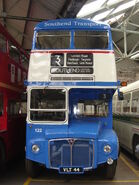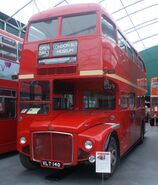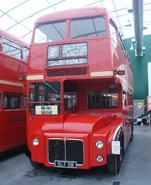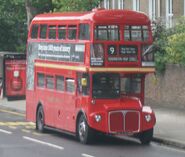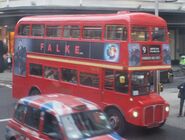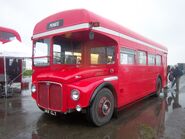
AEC Routemaster
The AEC Routemaster is a double-decker bus built by Associated Equipment Company (AEC) in 1954 (in production from 1958) until 1968.
Front-engined buses generally with rear platforms, a small number were produced with doors and/or front entrances. Introduced by London Transport in 1956, the Routemaster saw continuous service in London until 2005, and remains on two heritage routes in central London.
The Routemaster was developed by AEC in partnership with London Transport, the customer for nearly all new Routemasters, although small numbers were also delivered to the airline British European Airways (BEA) and the Northern General Transport Company. 2,876 Routemasters were built, with approximately 1,000 still in existence.
A pioneering design, the Routemaster outlasted several of its replacement types in London, survived the privatisation of the former London Transport bus operators and was used by other operators around the UK. In modern UK public transport bus operation, the old-fashioned features of the standard Routemaster were both praised and criticised. The open platform, while exposed to the elements, allowed boarding and alighting away from stops; and the presence of a conductor allowed minimal boarding time and optimal security, but with greater labour costs.
The Routemaster became one of London's most famous symbols, with much tourist paraphernalia continuing to bear Routemaster imagery, and with examples still in existence around the world. Despite its fame, the earlier and more numerous London bus classes that the Routemaster replaced (the RT-type AEC Regent and its Leyland Titan RTL and RTW counterparts) are often mistaken for Routemasters by the public and by the media.
Despite the retirement of the original version, the Routemaster has retained iconic status, and in the late 2000s work began on an updated version, which entered service in February 2012.
Design[]
The Routemaster bus was developed in 1947–1956 by a team directed by A. A. M. Durrant and Colin Curtis, with vehicle styling by Douglas Scott. The design brief was to produce a vehicle that was lighter (hence more fuel efficient) and easier to operate and that could be maintained by the existing maintenance practices at the recently-opened Aldenham Works. The resulting vehicle seated 64 passengers despite being three-quarters of a ton lighter than the RT family, which seated 56. The first task on delivery to service was to replace London's trolleybuses, which had themselves replaced trams, and to begin to replace the older types of diesel bus. The Routemaster was intended for London use, being designed by London Transport and constructed at the AEC Works in Southall, Middlesex, with assembly at bodybuilder Park Royal Vehicles, a subsidiary company of AEC.
It was an innovative design and used lightweight aluminium and techniques developed in aircraft production during World War II. As well as a novel weight-saving integral design, the Routemaster also introduced for the first time on a bus independent front suspension, power steering, a fully automatic gearbox and power-hydraulic braking. This surprised some early drivers, who found the chassis unexpectedly light and nimble compared with older designs, especially as depicted on film on tests at the Chiswick Works "skid pan". Footage of RM200 undergoing the skid test at Chiswick was included in the 1971 film On the Buses.
The Routemaster was a departure from the traditional chassis/body construction method. It was one of the first "integral" buses, with a combination of an "A" steel sub-frame (including engine, steering and front suspension) and a rear "B" steel sub-frame (carrying rear axle and suspension), connected by the aluminium body. The gearbox was mounted on the underside of the body structure with shafts to the engine and back axle.
Prototypes[]
London Transport's four prototype Routemasters were placed in service between 1956 and 1958. The first two were built at the London Transport works at Chiswick, the third at Addlestone by Weymann and the fourth, an experimental Green Line coach, at Eastern Coach Works at Lowestoft. The third and fourth had Leyland engines. The Routemaster was first exhibited at the Earl's Court Commercial Motor Show in 1954.
In 1961, 24 longer RMLs (30 ft compared with the standard 27 ft 6in) were built as a test, going into production from 1965.
In 1962, the front entrance RMF concept was tried, with RMF1254 based on the trial RMLs. This was exhibited and toured, leading to a small number of RMF and RMA buses.
In 1964, just before mainstream production of the RML, the final front-engined Routemasters, AEC started work on a front-entrance, rear-engined prototype, FRM1. Completed in 1966, it saw regular London service, then on tour operations, before being withdrawn in 1983. It acquired the nickname "Fruitmaster".
Production[]
Production of mechanical components was undertaken chiefly at AEC's Southall site (though a significant number had Leyland engines) throughout the life of the Routemaster, with body construction and final assembly at Park Royal. AEC was taken over by Leyland Motors in 1962, Routemaster production ceased in 1968.
The majority of production examples were 27 feet 6 inches (8.4 metres) long, within maximum length regulations. The regulations were later relaxed and 30 feet (9.1 metres) "long" types were produced, although these were delayed by union resistance to the extra work for conductors.
The production classes were designated as follows:
- RM - standard bus (27.5 feet (8.4 m))
- RML - long bus (30 feet (9.1 m))
- RMC - coach (27.5 feet (8.4 m))
- RCL - long coach (30 feet (9.1 m))
- RMF - front-entrance bus for Northern General
- RMA - front-entrance bus for BEA
RM and RML class[]
At 2,120 RMs and 524 RMLs, these make up the majority of Routemasters. The RML was a standard RM with a distinctive and seemingly out of place half-window section added in the middle giving eight extra seats. This was not a dramatic change, as it took advantage of the modular design approach of the Routemaster that would be copied by other manufacturers. RML was originally the "Routemaster Leyland" designation, with what became the RML called the ER, "Extended Routemaster". The RM and RML had a cubby hole beneath the rear staircase where the conductor could stand while not collecting fares without obstructing boarding/alighting passengers.
RMC and RCL class[]
The RMC was a coach version, produced for the "Green Line" routes. RMCs had modified suspension and interiors to allow a longer range and more comfortable running, and had an electrically operated door instead of an open platform. The RCL was a long version of the RMC with a larger engine and similar coach-style features.
RMF and RMA class[]
The RMF and RMA class were production versions of the front entrance Routemaster, primarily for non-London and airline use. Like the RMC/RCL they had an electrically operated door, but at the front of the bus along with the staircase. After being exhibited and demonstrated to other operators, the RMF attracted little interest, apart from an order from Northern General Transport Company (RMF) and, in a short version, from BEA (RMA).
Northern General[]
The British Electric Traction subsidiary, the Northern General Transport Company, introduced the RMF class in 1964/1965, with an initial batch of 18, followed by another 32 and later joined by the prototype RMF1254. This order created considerable interest and raised eyebrows within the bus industry, as Northern had been one of the biggest investors in the new rear-engined Leyland Atlanteans. However Northern shared many routes with their Tilling brothers United who operated the Bristol Lodekka and the Atlantean did not match the performance and passenger satisfaction of United's Bristols, so Northern brought in the front-entrance Routemaster as a better match. The fleet were fitted with Leyland engines and a higher-ratio rear axle for operation on longer trunk routes. Other notable differences were a standard single panel front destination blind screen, sliding windows and a one-piece driver's windscreen.
They operated in various Northern red and cream liveries receiving the poppy red corporate livery and NBC Northern fleetnames in the National Bus Company era. The RMF fleet wore the long-standing adverts characteristic of buses in the north-east of England, "Shop at Binns". Northern Routemasters where well liked by their crews: the high axle ratio meant a good turn of speed on long-distance routes such as Newcastle-Darlington, and power steering was well appreciated on busy urban services in Gateshead and Sunderland. Their service in the north also produced the odd sight of a Routemaster with a rollsign "X1 Scandinavia", connecting with the DFDS ferry from North Shields to Scandinavia. However throughout the 1970s it became increasingly uneconomic to have conductors on inter-urban services. Despite the driver and customer satisfaction for the Routemaster in the North East, the management had little option but to replace them. Northern placed a large order for Bristol VRs with either ECW highbridge or Willowbrook bodywork in 1977 to replace them. Routemasters were used until 1980, when they were disposed of in a variety of ways, some finding use in London, although none were deemed suitable for regular London service.
British European Airways[]
BEA introduced the RMA class built to the shorter length (with trailers) in various liveries in 1966/1967 on airport bus service between the West London Air Terminal (above the London Underground triangle between High Street Kensington, Gloucester Road and Earl's Court stations) and Heathrow Airport. These were all eventually sold to London Transport after being withdrawn in stages in the 1970s, finding various roles.
Colourful Routemasters[]
With the Routemaster's longevity, there have been Routemaster buses painted to celebrate both the Queen's Silver and Golden Jubilees, in 1977 and 2002 respectively. 25 buses were painted Silver to celebrate the Silver Jubilee, and out of 50 buses painted gold in London in 2002, 15 (12 RML, 3 RM) were Routemasters.
During privatisation in London, from 1986, several private operators won contracts to operate London bus services, some of which including Routemaster-operated routes. Before an 80% red rule for liveries was introduced in 1997 by LT, the contract tendering authority, some of these new entrants ran Routemasters in non-red liveries, most notably Kentish Bus on Route 19 and Borehamwood Travel Services (BTS) (now part of London United Busways) on Route 13.
The iconic nature of the Routemaster also appealed to the many new operators outside of London that appeared post-1986 in the UK following bus deregulation. Several operators took second-hand Routemasters as a cheap way of expanding their fleets to stave off competition from new operators emerging after deregulation. Start-up operators also chose the Routemaster as a distinctive-looking bus. Routemasters were seen around the country painted in a variety of colours, and were used in regular service in Southampton, Blackpool, Glasgow, Perth, Dundee, Hull, Carlisle, Bedford, Corby, Manchester (Stagecoach), Southend and Burnley. During this era, several Routemasters found their way through more than one company and were also often loaned between operators.
One of the earliest, if not the earliest, examples of deregulated use of Routemasters was early in the history of the Stagecoach Group. Now one of the largest operators in the UK, Stagecoach combined vintage Routemasters with its new and striking corporate livery of all-over white with red, orange and blue stripes, to start one of their first operations, Magic Bus, in Glasgow, Scotland, in the late 1980s. This contrasted with traditional identities still in use at the time.
Towards the end of this period, in 1994 in Reading, new operator Reading Mainline built up a 45-strong Routemaster fleet to compete with the established operator Reading Buses, in the process becoming the largest operator of Routemasters outside London. They used conductors to compete on speed in the town centre and, in the outskirts, took advantage of the rear platform to operate hail and ride sections of route. After building up a network covering nearly the whole town, Reading Buses posted their first financial loss to purchase the company in 1998, with Reading Buses continuing Routemaster operation, albeit reduced in number, until 2000.
With the costs involved in running elderly two-person buses and with a general reduction in the number of operators, buses and services in the years following deregulation industry as competitors merged or sold out, examples of use outside London declined through the 1990s. Many of these buses found their way back to London to assist with the refurbishment program, as spares donors or to increase fleet size.
Withdrawal from mainstream London service saw another resurgence in the use of Routemasters outside London but on a smaller scale than post deregulation. Post 2000, usage was characterised by small novelty or seasonal routes.
Green livery[]
Green Routemasters worked for LT's country bus division, which took coach-type RMCs and RCLs for Green Line services, and later RMLs. The RMC class were initially used on Green Line routes in outlying towns. The RCL entered service in areas where the RMC was not introduced.
These vehicles passed to the nationalised National Bus Company's subsidiary London Country Bus Services (known as London Country) in 1969, which took over outlying areas of LT bus operation resulting from the 1968 Transport Act. The transfer comprised 69 RMCs, 43 RCLs and 97 RMLs.
By the latter half of the 1970s, most of these vehicles had been re-acquired by London Transport, as London Country modernised and standardised its fleet and as increased car usage and improved commuter railways reduced suburban bus demand. Most of the RMLs found use on red London bus routes, and the RMCs and RCLs were cascaded into the training fleet. As the RCL class was relatively new in Routemaster terms and LT was suffering from lack of parts, between 1980 and 1984 several RCLs were converted to bus use.
Rise and decline[]
Heyday at London Transport[]
The heyday of Routemaster operation was its first 25 years of operation, until September 1982, when the type started to be withdrawn and transferred to training fleets, due to service reductions.
The RM class was placed in service from 1959 to replace trolleybuses, which finished in May 1962. Subsequent Routemasters, the last 500 of which were RMLs, began replacing the previous generation of buses, the AEC Regent RT and Leyland Titan RTL and RTW. RMLs also displaced RMs on central routes to cope with higher loadings. The last Routemaster, RML2760, entered service in March 1968.
The original London Transport concept included the routine overhaul and refurbishment of the fleet at its Aldenham Works, usually every five years. The buses were completely stripped down and rebuilt, and left the works almost as new. As the number of Routemasters declined and newer buses not suited to this practice were introduced, the overhaul routine was abandoned and Aldenham Works closed in the mid-1980s.
Decline in London[]
Many of London's bus routes were converted to one-person operation (then known as one-man operation, or OMO) in the 1970s, out of a desire to reduce operating costs and address staff shortages. There was also for a time a parts shortage for Routemasters, aggravated by the closure of AEC. With the introduction of single-deck Red Arrow services in London and successful conversion to modern rear-engined OMO buses around the country, LT was considering replacing Routemasters with modern buses. The operation of the Routemaster gradually contracted to central areas only, with RMLs replacing RMs, where LT felt that the Routemaster still provided an efficient means of transporting large enough numbers of people to justifying the economics of two-person operation. The rapid acceleration and rugged construction of the Routemaster proved to be more suited to urban conditions than some more modern designs.
The Routemaster fleet remained largely intact for around 15 years after production ended in 1968, with withdrawals mainly due to fires. Following the defeat of the GLC in the House of Lords regarding its subsidised fare scheme, major service reductions followed in September 1982. Consequently the first withdrawals commenced, with many of these early disposals being for scrap. The continued practice of route conversion to one-person operation resulted in a steady trickle of withdrawals. This practice had largely halted by 1988, with comparatively few withdrawn up to 1992.
In the 1980s, several of the returned Routemasters purchased from Northern General, BEA and London Country, which had doors rather than an open platform, were put to use on London Transport's revived sightseeing operation The Original London Sightseeing Tour, alongside the RCL class (some converted to open top buses), the RMF class, and the RMA class.
Privatisation of London buses[]
In 1984, the privatisation of London bus services began and the Routemasters were transferred from London Transport operation to several different arm's-length business units based on different garages, leading to minor additions to the standard red livery. Nine of the 12 new operating units inherited Routemasters, Centrewest, Leaside, London Central, London General, London United, Metroline, London Northern, South London and East London. During this time, following the failure and premature withdrawal of heralded replacement vehicle classes such as the DM/DMS class Daimler Fleetline, the Routemasters that had not yet been disposed of saw their lives extended for use until privatisation. Where new route tenders called for Routemaster operation, these were leased from London Buses.
By 1994, all the operating units had been sold and this produced livery variations and additions to some Routemasters from their previous all-over red livery. In the new London route tendering process, all but one of the Routemaster operated routes were allowed to keep their now privately-owned Routemasters for the five-year contract period and further refurbishments resulted.
Life extensions[]
Since the ending of production at Southall and later closure of the Aldenham works, new options for extending the life of the Routemaster became necessary if they were to continue to run. This made sense as even by 1987, when some buses looked decidedly worn out, inspections by London Buses revealed the basic structure of the buses was still sound, requiring only replacement of engines and interior/exterior renewal.
From 1992 to 1994, all but two of the RMLs were refurbished for ten years' further service. This work, which included updating the interior to modern tastes and substituting Iveco or Cummins engines, was carried out by Mainline, TB Precision, Nottingham Truck & Bus and by one of the new London Buses business units, Leaside Buses. 100 RMs were also re-engined. Post-privatisation, in 1996, London Central's RMs on route 36, Stagecoach London's RMLs for routes 8 and 15, and Arriva's RMs for route 159 received new Scania engines. Between 2001 and 2004, under new mayor Ken Livingstone and Transport for London, the replacement authority for London Buses, further refurbishment saw TfL buy back 49 RMs from a variety of sources. Initially started by Marshall Bus, this was continued by Arriva London when Marshall ceased trading in 2002.
Withdrawal from London[]
During the new millennium, debates surrounded the issue of whether to replace or retain the Routemaster in London service. Supporters cited its continued mechanical fitness, speed of boarding and tourist potential, while opponents pointed to the economics of running increasingly elderly buses when newer, larger and more modern designs were now on the market following a resurgence in the bus manufacturing industry after recession in the 1990s. Opponents also pointed specifically to the lack of accessibility of the Routemaster in light of impending relevant legislation, which meant all new buses now entering service in London were of a low-floor design. The emergence of off-bus ticketing technology also reduced the argument for better dwell times, whereby the Oyster card and off-bus ticket machines would reduce the time it took to board the bus.
In 2004, following his second election campaign, Mayor of London Ken Livingstone announced the phasing out of the type in order to provide a bus service in the capital fully accessible to wheelchair users. Government legislation requires full accessibility by 2017 under the Disability Discrimination Act. As a consequence, the Routemaster was officially withdrawn from general service on 9 December 2005, although it remains in regular service on two "heritage" routes (see below).
Withdrawals began on the dates below as the five-year contracts expired.
- Route 15: 29 August 2003
- Route 11: 31 October 2003
- Route 23: 14 November 2003
- Route 94: 23 January 2004
- Route 6: 26 March 2004
- Route 98: 26 March 2004
- Route 8: 4 June 2004
- Route 7: 2 July 2004
- Route 137: 9 July 2004
- Route 9: 3 September 2004
- Route 390: 3 September 2004
- Route 73: 3 September 2004; replaced by bendy buses
- Route 12: 5 November 2004; replaced by bendy buses
- Route 36: 28 January 2005
- Route 19: 1 April 2005
- Route 14: 22 July 2005
- Route 22: 22 July 2005
- Route 13: 21 October 2005
- Route 38: 28 October 2005; replaced by bendy buses
- Route 159: 9 December 2005
The Routemaster was gradually phased out of service by the end of 2005. A television documentary shown that year revealed that Livingstone had commented in 2001 that "only some sort of ghastly dehumanised moron would want to get rid of Routemasters". By December 2005, only one route was left, the 159 (Marble Arch — Streatham). Friday, 9 December 2005 was the last official running day. On Thursday 8th, 24 special buses, including preserved RMs and RMLs and their predecessors from the "RT" bus family made guest appearances on the 159 route.
On Friday, instead of doing a normal shift with crews ending normally at around 23:00, on police advice the day was split into two duty shifts, a Routemaster shift and a VLA class shift (Volvo B7TL/Alexander ALX400), the replacement bus for route 159, with the Routemasters replaced in the middle of the day.
Towards the last runs to the garage, crowds blocked the four-lane road, bringing all traffic to a standstill. RM2217 was set to be the last official running bus, as per the timetable. Heavily delayed, it took 10 minutes to turn the final corner into Brixton Garage.
The bus left the public highway at 14:07, accompanied by duplicates provided using preserved RM5 and RM6. Due to the delays, RM54 was actually the last in service, running into Streatham Station stand a few minutes later, before running dead to Norwood Garage.
Later, RM5 and RM6 followed by RM2217 were moved to the old LCC Tramways depot at Brixton for press photographs in the quieter surroundings of the old depot complete with visible tramlines.
Current usage[]
London heritage routes[]
Two heritage routes were immediately introduced in London, recognising the nostalgia for the type among ordinary Londoners and their appeal to tourists. Although these buses are operated under contract to TfL and accepted standard Travelcards, Oystercards or cash fares, they operated for a limited time during the day duplicating short sections of two regular London bus routes. The Heritage routes operate around ten buses each, with five each in reserve.
- Heritage route 9: Olympia-Warwick Gardens - High Street Kensington - Royal Albert Hall — Hyde Park Corner — Piccadilly Circus — Trafalgar Square.
- Heritage route 15: Trafalgar Square — Strand — Aldwych — Fleet Street — Cannon Street — Monument — Tower Hill.
The buses used were specially restored for this service and have clean environmental engines, modern electrics and sealed windows.
Other public transport uses[]
Most use of Routemasters in UK public transport service has now ceased.
On 7 April 2008 Routemasters were introduced on a regular bus route in Nottingham, England. They were operated by Bellamy's Coaches Ltd with red Routemasters branded as the Nottingham & District Omnibus, on route 20 on a 20-minute frequency from 07:00 to 19:00, six days a week. Bellamy's positioned the conductor and open platform features of the Routemaster as being able to compete with the incumbent operator Nottingham City Transport's (NCT) services, with increased speed through the city centre bus stops, and through hail and ride operation in the suburbs. The Routemasters were withdrawn on 28 June 2008 with the company citing low passenger demand, although to satisfy bus service registration requirements the service continued, using single-decker buses, into August. The council, which has an 82% stake in NCT, was criticised for not doing enough to provide information about the service in public facilities, and for increasing the competition selectively on the Routemaster route.
The London and south east of England operator Metrobus retained green-liveried Routemaster RML2317 from sister company London General, which is sometimes used on regular routes as well as private and preservation appearances. It then passed to Brighton and Hove Buses where it was painted into the livery of Thomas Tilling Ltd. Cavendish Motor Services operates RML2324 in a light green and green livery, for special journeys and as a relief bus on its routes in the Eastbourne area.
Wilson's Coaches of Greenock operates three Routemasters (one open-top) mainly on private hire workings, but also see service on routes from Greenock to Clydebank, Helensburgh and on Saturdays prior to Christmas on the local Greenock service.
Non-public service use[]
Aside from the London heritage routes, the last major operator of Routemasters in service in the UK is in Edinburgh, Scotland. Local operator Lothian Buses' tour operation Mac Tours uses closed and open top Routemasters on regular tours. Another tour operation, York Pullman, currently uses two Routemasters on a city tour of York.
Several operators in the UK maintain Routemasters for private hires, with the majority held by the successors to the former London Bus units, Ensignbus, London Bus Company Ltd (formerly Blue Triangle) and Timebus Travel.
Many cities around the world have a Routemaster or an RT variant, often privately owned and used for many different purposes from preservation to hot dog stands, tour bus to shop. Routemasters are in places such as Sri Lanka, Australia, New Zealand, China, Canada, Croatia, Southern California, Malaysia, Fairbanks, Alaska, and Stanley in the Falkland Islands.
A number of Stagecoach-owned Routemasters have been exported to Montreal in Canada, where Stagecoach provides a tourist service around the city. This is a unique case of London Routemasters being operated on a daily service in a foreign country by a former London Routemaster operator.
In popular culture[]
In the 2011 film Cars 2, a Routemaster is set to appear as Topper Deckington III. A Routemaster has appeared in the Railway Series as Bulgy, who has also appeared in the TV spin-off, Thomas the Tank Engine & Friends.
New Bus for London[]
Such was the popularity of the Routemaster that many calls continued to be made for a new version of the vehicle to be produced. Conservative Mayoral candidate for London, Boris Johnson on 3 September 2007 announced that he was contemplating introducing a modern-day version of the Routemaster (and scrapping bendy bus operation). In December 2007, UK magazine Autocar commissioned leading bus designer Capoco, designer of the innovative Optare Solo, to come up with detailed proposals for a new-generation Routemaster. Johnson backed the Capoco design in principle and suggested that he would hold a formal design competition to develop a new Routemaster if he became London mayor in 2008. After he was elected, this competition was held for general ideas and detailed designs, with cash prizes for the winning entries. The results of the competition were published on 19 December 2008, with the winning and other good proposals being passed to bus manufacturers to draw up a final design. The winners included two joint 'whole bus' designs, one submitted by Capoco and one submitted by Aston Martin and Foster and Partners.
The brand-new Routemaster was put into service in February 2012.
Skopje City Master[]
In 2010, the government of the Republic of Macedonia ordered 202 double-decker buses from the Chinese manufacturer Yutong, two of which were cabriolet buses with removable roofs to be used by tourists (15 more buses like these were ordered in late 2011) and the remaining 200 as city buses for the capital city of Skopje. The buses were to be in a "retro" style, similar to Routemasters. Former London double-deckers were used in Skopje until the 1963 Skopje earthquake in which 75%-80% of the city's infrastructure was destroyed. The prototype bus appeared on the streets of Skopje on 1 March 2011, under the name ZK6116HGS. The first cabriolet buses with removable roofs and 65 city buses were put into service on 6 September 2011, all under the name City Master. The rest of the buses, as well as another 15 cabriolet buses with removable roofs ordered in late 2011, are expected to arrive by the end of 2013.
Preservation[]
Ensign[]
Several Routemasters were sold to preservation groups. Ensignbus, the bus dealer, handled disposals by the hundreds, as it also did for other London buses. In December 2004, Ensignbus held a raffle for 32 Routemasters, available for £2,000 to those who could prove they had the finances to store and care for them. Ensignbus has since opened a transport museum, which contains several preserved examples.
50th Anniversary[]
On 25 July 2004, in Finsbury Park, London, over 100 preserved Routemasters, were lined up, in celebration of the 50th anniversary of the first appearance of the Routemaster.
Jeremy Clarkson[]
In October 2008, British television presenter and motoring personality Jeremy Clarkson caused controversy when he destroyed a Routemaster in a stunt to promote his new DVD. In response, a spokesman for Clarkson's production company stated, "What [Clarkson] wants to blow up for his own and the viewers' entertainment, is up to him...it's a well-known fact that he isn't fond of buses."
Notable examples[]
- Cobham Bus Museum (now the London bus museum) has the third prototype, RML3 (L in this case stood for Leyland). This vehicle has had a replica of its original front fitted.
- Prototype coach RMC4 (originally CRL4) is preserved by Roger Wright of the London Bus Company and is being fitted with a replica of its original front.
- On April 28, 2010, Roger Wright repatriated RM1371 and RM1620, along with seven RTs and two RTLs from Charlottetown, Prince Edward Island, Canada. London Bus Company purchased the fleet from Charlottetown-based Abegweit Tours and Travel Agency Inc., which had operated them since 1965. The buses were driven to Halifax, Nova Scotia for shipment to the UK. Some are destined for tourist operation in London while the remainder will be preserved in museums.
- The first production Routemaster, RM8, is preserved by the RM8 Club. It was displayed at the 1958 Commercial Vehicle Show as the new bus for London. It was employed at LT Chiswick as an experimental vehicle upon which many Routemaster modifications were tested. The bus finally entered public service at Sidcup (SP) garage in March 1976, being the last Routemaster to enter service and the last open-platform bus to be introduced into service in the UK. It served LT at Sidcup garage until the garage went "one-person" in 1985. It then entered preservation with the RM8 Group, which subsequently became the RM8 Club. In July 2008 it was preserved in its 1958 Commercial Vehicle Show appearance, complete with replica posters and blinds.
- The 1000th Routemaster, RM1000, was handed over to London Transport with a ceremony at Southall Works on 16 October 1961, and adopted as a showbus by staff at Croydon Garage. This bus passed to the RM1000 Preservation Group for preservation in May 1987.
- The unique rear-engined front entrance Routemaster, FRM1, was transferred to the London Transport Museum for preservation in 1983. Also in the collection are prototypes RM1 and RM2. RM2 is undergoing work at the Acton Depot to fit a replica of its original front end.
- One of the last running Routemasters, RM54, was purchased from TfL in April 2006 for preservation by Ensignbus.
- RM1737 was the show bus of Ash Grove Garage in the early 1980s. It passed into TfL ownership and is displayed at the London Transport Museum
- RM737 was the show bus at Harrow Weald garage and, despite being in daily service on route 140, was regularly seen at preservation rallies. Purchased by the show bus team when route 140 was converted, it was the first standard example in preservation.
- RM2217, the last departure on the 159, has been retained by Arriva in its Heritage Fleet, along with RM5 and RM6, and the first production RMC coach RMC1453 among others.
- RML2537 is preserved in open-top form at Long Beach, California and operated in connection with the RMS Queen Mary, permanently berthed there as a floating hotel.
- The last Routemaster built for London, RML2760, is retained by Stagecoach London.
- The first RCL, RCL2218, is preserved in excellent condition at the Nottingham Transport Heritage Centre.
- Several Routemasters were painted gold for the Queen's Golden Jubilee in 2002.

